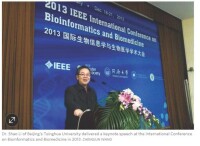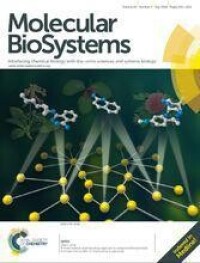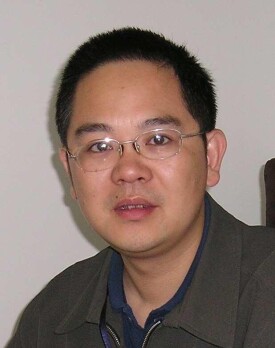李梢
李梢
李梢,1973年10月出生於醫學世家,清華大學教授、博士生導師、清華信息國家實驗室中醫藥交叉研究中心主任、生物信息學部副主任。在Molecular Systems Biology, Cancer Research等刊物發表論文100餘篇,代表論文兩次被《自然中國》(Nature China)作為亮點報道,被國際千名醫學家(F1000)推薦為“必讀論文” ,被美國《華爾街日報》長篇報道,評為“2014世界中醫藥十大新聞” ,入選英國皇家化學會“Top 1%高被引中國作者”。由於在中醫藥網路藥理學上的開拓性工作和成果,獲2012年國家傑出青年科學基金。兼任世界中醫藥學會聯合會網路藥理學專業委員會會長、中國藥理學會網路藥理學專業委員會副主任委員、中國研究型醫院學會生物標誌物專業委員會副主任委員。
北京中醫藥大學醫學博士(1998.9-2001.7)
皖南醫學院醫學碩士(繼承家族醫學-國家非物質文化遺產)(1995.9-1998.7)
北京中醫藥大學醫學學士(1990.9-1995.7)
清華大學 教授(2009.12至今)
清華大學 博士生導師(2008.9至今)
清華信息科學與技術國家實驗室(籌)中醫藥交叉研究中心主任(2017.9至今)
清華信息科技國家實驗室(籌)生物信息學研究部 副主任(2006.2至今)
清華大學自動化系、生物信息學教育部重點實驗室副研究員(2004.12-2009.11)
清華大學自動化系、生物信息學教育部重點實驗室講師(2003.8-2004.12)
清華大學自動化系、生物信息學教育部重點實驗室博士后(2001.9-2003.8)
網路藥理學、生物信息學與中醫藥現代化
疾病分子網路研究:分析表型與複雜生物網路的整體關聯機制,研究炎症與腫瘤、中醫寒熱證等病證的分子網路和生物標誌
中藥網路藥理學研究:以疾病生物分子網路為靶標,研究中藥藥效物質基礎和中藥方劑作用機理
大挑戰2015·青年科學家(蓋茨基金會,科技部)
國家傑出青年科學基金(2012)
國家教學成果二等獎(2009)
國家科技進步二等獎(2004)
茅以升北京青年科技獎(2009)
教育部新世紀優秀人才支持計劃(2007)
全國優秀博士學位論文(2003)
清華大學校先進工作者(2008)
1. 國家自然科學基金重點項目(2010-2013,負責人):疾病生物分子網路的系統建模與調控機理研究
2. 國家自然科學基金面上項目(2009-2011,負責人):基於血管新生生物網路的方劑多靶點協同作用研究
3. 國家自然科學基金重大研究計劃面上項目(2007-2009,負責人):寒熱辨證的多層次信息挖掘及相關生物分子網路
4. 863計劃探索導向項目(2006-2008,負責人):疾病相關生物網路構建分析的關鍵方法與技術
5. 國家科技支撐計劃課題(2006-2009,負責人):中醫證候計算系統生物學方法的示範研究
6. 教育部科學技術研究重點項目(2004-2006,負責人):細胞因子網路模擬與中藥免疫調節模式研究
7. 全國優秀博士論文作者專項資金(2004-2009,負責人):中藥分子組合調節血管增生的理化與生物信息研究
8. 國家自然科學基金青年項目(2003-2005,負責人):基於神經內分泌免疫網路模擬的寒熱證候整體規律研究
2012年,清華大學李梢教授由於在中醫藥生物信息學、中藥網路藥理學上的開拓性工作和成果,成為2012年度中醫藥學科唯一的國家傑出青年基金獲得者,也是“中醫藥學研究新技術和新方法”領域首位國家傑青。
2013年,李梢課題組在中醫證候生物學研究上獲新進展,連續發表了中醫證候生物標誌和舌苔微生物組的研究成果。
2014年,李梢課題組的六味地黃方網路藥理學研究論文登上國際刊物封面。
2014年11月,美國《華爾街日報》以“古老療法的新資料”為題,用兩個版面刊發了一則頭條報道,其中重點介紹了李梢課題組的研究成果,該新聞入選“2014世界中醫藥十大新聞”。
2015年,李梢提出了中藥新作用機制模型——基於網路靶標的效應開、關模型,為優化中藥組方、促進藥物研製提供了新思路。
2016年,李梢由於在中藥網路藥理學上的研究成果,入選英國皇家化學會“Top1%高被引中國作者”榜單。
2017年,李梢課題組在Cancer Research建立了消化道炎癌轉化的分子-細胞-系統多尺度計算模型,為揭示炎癌轉化規律、發展防控措施提供新途徑。11月,李梢課題組在胃炎寒熱證分子網路、六味地黃網路調節作用、中藥網路靶標模型方面的三項成果,得到美國NIH/NCI腫瘤補充與替代醫學研究戰略白皮書的引證和好評。
2018年4月,李梢課題組成果“打造大數據和人工智慧時代的中醫藥“核芯”技術”亮相首屆數字中國建設峰會。

《華爾街日報》報道

《華爾街日報》刊登的李梢作大會報告照片

李梢課題組的六味地黃方網路藥理學研究論文登上國際刊物封面
主要學術論文(*:通訊作者)
2017
1.Guo Y, Nie Q, MacLean A, Li Y, Lei J*, Li S*. Multiscale modeling of inflammation-induced tumorigenesis reveals competing oncogenic and onco-protective roles for inflammation. Cancer Research 2017;77(22):6429-6441
2.D Xi*, T Bao, Qi Chen, S Chen, Y Cheng, J Cullen, D Frank, J Friedberg, I Kronish, J Lee, M Levine, P Li, S Li, W Lu, J Mao, S Keefe, L Rubinstein, M Shah, L Standish, C Paller, E Chu. State of the Science: Cancer Complementary and Alternative Medicine Therapeutics Research—NCI Strategic Workshop Highlights of Discussion Report. JNCI Monographs 2017;52:lgx003
3.Zhang B, Wang X, Li Y, Wu M, Wang S, Li S*. Matrine is identified as a novel macropinocytosis inducer by a network target approach. Frontiers in Pharmacology (Accepted)
4.Lin X, Hu L, Gu J, Wang R, Li L, Tang J, Zhang B, Yan X, Zhu Y, Hu C, Zhou W, Li S, Liu J, Gonzalez F, Wu M, Wang H*, Chen L*. Choline Kinase Alpha mediates interactions between the Epidermal Growth Factor Receptor and mTORC2 in hepatocellular carcinoma cells to promote drug resistance and xenograft tumor progression. Gastroenterology 2017;152:1187–1202
5.Huang Q, Xu L, Qu W, Ye Z, Huang W, Lin J, Li S*, Ma H*. TLC Bioautography-guided Isolation of Antioxidant Activity Components of Extracts from Sophora flavescens Ait. European Food Research and Technology 2017;243:1127-1136
2016
1.Li S*. Exploring traditional Chinese medicine by a novel therapeutic concept of network target. Chinese Journal of Integrative Medicine 2016;22(9):647-652 (Feature Article)
2.Qi Q, Li R, Li H, Cao Y, Bai M, Fan X, Wang S, Zhang B*, Li S*. Identification of the anti-tumor activity and mechanisms of nuciferine through a network pharmacology approach. Acta Pharmacologica Sinica 2016;37:963-972
3.Zhang Y, Mao X, Guo Q, Bai M, Zhang B, Liu C, Sun Y, Li S*, Lin N*. Pathway of PPAR-gamma coactivators in thermogenesis: a pivotal traditional Chinese medicine-associated target for individualized treatment of rheumatoid arthritis. Oncotarget 2016;7(13):15885-15900
4.Zhang Y, Mao X, Guo Q, Lin N, Li S*. Network pharmacology-based approaches capture the essence of Chinese herbal medicines. Chinese Herbal Medicines 2016;8:107-116
2015
1.Li S*. Mapping ancient remedies: applying a network approach to traditional Chinese medicine. Science 2015;350(6262 Suppl):S72-S74 (傳統醫學增刊)
2.Wu M, Lu P, Shi L*, Li S*. Traditional Chinese patent medicines for cancer treatment in China: a nationwide medical insurance data analysis. Oncotarget 2015;6(35):38283-38295
3.Zu S, Chen T, Li S*. Global optimization-based inference of chemogenomic features from drug-target interactions. Bioinformatics 2015;31(15):2523-2529
4.Zhang B, Lu C, Bai M, He X, Tan Y, Bian Y, Xiao C, Zhang G, Lu A*, Li S*. Tetramethylpyrazine identified by a network pharmacology approach ameliorates methotrexate-induced oxidative organ injury. Journal of Ethnopharmacology 2015;175:638-647
5.Zhang Y, Bai M, Zhang B, Liu C, Guo Q, Sun Y, Wang D, Wang C, Jiang Y, Lin N*, Li S*. Uncovering pharmacological mechanisms of Wu-tou decoction acting on rheumatoid arthritis through systems approaches: drug-target prediction, network analysis and experimental validation. Scientific Reports 2015; 5: 9463
6.Li Y, Li R, Ouyang Z, Li S*. Herb network analysis for a famous TCM doctor’s prescriptions on treatment of rheumatoid arthritis. Evidence-Based Complementary and Alternative Medicine 2015: 451319
7.Su B, Luo T, Zhu J, Fu J, Zhao X, Chen L, Zhang H, Ren Y, Yu L, Yang X, Wu M, Feng G, Li S, Chen Y*, Wang H*. Interleukin-1β/IRAK-1 inflammatory signaling contributes to persistent Gankyrin activation during hepatocarcinogenesis. Hepatology 2015;61(2):585–597
2014
1.Liang X, Li H, Li S*. A novel network pharmacology approach to analyse traditional herbal formulae: the Liu-wei-di-huang Pill as a case study. Molecular BioSystems 2014,10(5):1014-1022 (封面論文)
2.Wang L, Wang Y, Hu Q, Li S*. Systematic analysis of new drug indications by drug-gene-disease coherent subnetworks. CPT: Pharmacometrics and Systems Pharmacology 2014;3:e146, 9 pages
3.Liang X, Li H, Tian G, Li S*. Dynamic microbe and molecule networks in a mouse model of colitis-associated colorectal cancer. Scientific Reports 2014;4,4985
4.Li S*, Fan T, Jia W, Lu A, Zhang W. Network pharmacology in traditional Chinese medicine. Evidence-based Complementary and Alternative Medicine 2014:138460 (Editorial)
5.Li H, Zhao L, Zhang B, Jiang Y, Wang X, Guo Y, Liu H, Li S*, Tong X*. A network pharmacology approach to determine active compounds and action mechanisms of Ge-Gen-Qin-Lian decoction for treatment of Type 2 diabetes. Evidence-based Complementary and Alternative Medicine 2014:495840
2013
1.Li R, Ma T, Gu J, Liang X, Li S*. Imbalanced network biomarkers for traditional Chinese medicine Syndrome ingastritis patients. Scientific Reports 2013;3:1543
2.Li S*, Zhang B. Traditional Chinese medicine network pharmacology: theory, methodology and application [中藥網路藥理學:理論、方法與應用]. Chinese Journal of Natural Medicines 2013;11(2):110-120
3.Zhang B, Wang X, Li S*. An integrative platform of TCM network pharmacology and its application on an herbal formula, Qing-Luo-Yin. Evidence-based Complementary and Alternative Medicine 2013:456747
4.Zhang B, Liu L, Zhao S, Wang X, Liu L, Li S*. Vitexicarpin acts as a novel angiogenesis inhibitor and its target network. Evidence-based Complementary and Alternative Medicine 2013:278405
5.Wang T, Gu J, Yuan J, Tao R, Li Y, Li S*. Inferring pathway crosstalk networks using gene set co-expression signatures. Molecular BioSystems 2013;9(7):1822-1828
2012
1.Jiang B, Liang X, Chen Y, Ma T,Liu L, Li J, Jiang R, Chen T, Zhang X*, Li S*. Integrating next-generation sequencing and traditional tongue diagnosis to determine tongue coating microbiome. Scientific Reports 2012;2:936
2.Zhao S, Li S*. A co-module approachfor elucidating drug-disease associations and revealing their molecular basis. Bioinformatics 2012;28(7):955-961
3.Chen Y, Gu J, Li D, Li S*. Time-course network analysis reveals TNF-alpha can promote G1/S transition of cell cycle in vascular endothelialcells. Bioinformatics 2012;28(1):1-4
4.Gu J*, Li S*. Towards integrative annotating the cell-type specific gene functional and signaling map in vascular endothelial cells. Molecular BioSystems 2012;8:2041-2049
5.Kanawong R, Ajayi T, Ma T, XuD, Li S*, Duan Y*. Automated tongue feature extraction for ZHENG classificationin traditional Chinese medicine. Evidence-based Complementary and Alternative Medicine 2012;912852:1-14
2011
1.Li S*, Zhang B, Zhang NB. Network target for screening synergistic drug combinations with application to traditional Chinese medicine. BMC Systems Biology 2011;5(S1):S10 (F1000推薦論文)
2.Yao X, Hao H, Li Y, LiS*. Modularity-based credible prediction of disease genes and detection of disease subtypes on the phenotype-gene heterogeneous network. BMC SystemsBiology 2011;5:79
3.Lu L, Li Y, Li S*. Computational identification of potential microRNA network biomarkers for the progression stages of gastric cancer. International Journal of Data Mining and Bioinformatics 2011;5:519-31
4.李梢. 網路靶標:中藥方劑網路藥理學研究的一個切入點。中國中藥雜誌 2011;36:2017-2020
2009-2010
1.Zhao S, Li S*. Network-based relating pharmacological and genomic spaces for drug target identification. PLoSONE 2010;5(7):e11764 (Nature China 亮點論文)
2.Li S*, Zhang B, Jiang D, Wei YY, Zhang NB. Herb network construction and co-module analysis for uncovering the combination rule of traditional Chinese herbal formulae. BMC Bioinformatics 2010;11(S11):S6
3.Yan H, Zhang B, Li S*, Zhao Q*. A formal model for analyzing drug combination effects and its application in TNF-alpha-induced NFkappaB pathway. BMC Systems Biology 2010;4:50
4.Ma T, Tan C, Zhang H, Wang M,Ding W, Li S*. Bridging the gap between traditional Chinese medicine and systems biology: the connection of Cold Syndrome and NEI network. Molecular BioSystems 2010;6:613-619
5.Gu J, Chen Y, Li S*, Li Y*. Identification of responsive gene modules by network-based gene clustering and extending: application to inflammation and angiogenesis. BMC Systems Biology 2010;4:47
6.Huang Y, Li S*. Detection of characteristic sub pathway network for angiogenesis based on the comprehensive pathway network. BMC Bioinformatics 2010;11(S1):S32
7.Yao BP, Li S*. ANMM4CBR: acase-based reasoning method for gene expression data classification. Algorithms for Molecular Biology 2010;5:14
8.Li S, Lu A*, Wang Y. Symptomatic comparisonin efficacy on patients with benign prostatic hyperplasia treated with two therapeutic approaches. Complementary Therapies in Medicine 2010;18:21-27
9.Li S. Network systems underlying traditional Chinese medicine syndrome and herb formula (Invited review). Current Bioinformatics 2009;4(3):188-196
10.李梢. 中醫證候生物分子網路標誌的構想與研究. 中醫雜誌 2009;50(9):773-776
2008
1.Wu X, Jiang R, Zhang MQ, Li S*. Network-based global inference of human disease genes. Molecular Systems Biology 2008;4:189 (Nature China 亮點論文)
2.Zhang J, Ma T, Li YD, Li S*. dbNEI2.0: building multilayer network for drug-NEI-disease. Bioinformatics 2008;24:2409-2411
3.Kang G, Li S*, Zhang JF. Entropy-based model for interpreting life systems in traditional Chinese medicine. Evidence-based Complementary and Alternative Medicine 2008;5(3):273-279
4.Wu M, Ma C, Wu Y, Li S*. Simultaneous LC analysis of five bioactive alkaloids in an anti-angiogenesis herbal formula, Qing-Luo-Yin. Chromatographia 2008;68:579-585
2007
1.Li S*, Zhang Z, Wu L, Zhang X, Li Y, Wang Y. Understanding ZHENG in traditional Chinese medicine in the context of neuro-endocrine-immunenetwork. IET Systems Biology 2007;1(1):51-60
2.Li S*, Fang YH. Modelling circadian rhythms of protein KaiA, KaiB and KaiC interactions in cyanobacteria. Biological Rhythm Research 2007;38(1):43-53
3.李梢. 基於生物網路調控的方劑研究模式與實踐. 中西醫結合學報 2007;5(5):1-5
4.李梢. 中醫藥計算系統生物學與寒熱證候研究. 世界科學技術-中醫藥現代化 2007;9(1):105-111
2006
1.Li S*, Wu LJ, Zhang ZQ. Constructingbiological networks through combined literature mining and microarray analysis: a LMMA approach. Bioinformatics 2006;22:2143-2150
2.Li S*, Wang R, Zhang Y, Zhang X, Layon AJ, Li Y, Chen M. Symptom combinations associated with outcome and therapeutic effects in a cohort of cases with SARS. American Journal of Chinese Medicine 2006;34(6):937-947
3.Zhuang YL, Li S*, Li YD. dbNEI: a specific database for neuro-endocrine-immune interactions. Neuroendocrinology Letters 2006;27:53-59
2005以前
1.Li S*, Lu A, Li B, Wang Y. Circadian rhythms on hypothalamic-pituitary-adrenal axis hormones and cytokines ofcollagen induced arthritis in rats. Journal of Autoimmunity 2004;22(4):277-285
2.Li S*, Lu A, Wang Y, Li Y. Suppressive effects of a Chinese herbal medicine Qing-Luo-Yin extract on the angiogenesis of collagen induced arthritis in rats. American Journal of Chinese Medicine 2003;31(5):713-720
3.李梢. 從維度與階度探討中醫證候的特徵及標準化方法. 北京中醫藥大學學報 2003;26(3):1-4
4.李梢,王永炎,季梁,李衍達. 複雜系統意義下的中醫藥學及其案例研究. 系統模擬學報2002;14(11):1429-1432
發明專利:
1. Li S, Zhang NB, Zhang B. Method of Network-Based Identification of Multicomponent Synergy and Compositions for Use as Effective Component of Anti-Angiogenesis Medicines. 授權美國發明專利. 專利號:US Patent: 12/436,844
2. 李梢,趙世文. 基於蛋白質網路的藥物靶標確定和/或藥物功能確定方法。申請中國發明專利、PCT專利。申請號:201010218468.X
3. 李梢,張寧波,張博. 基於基因網路的藥物組合協同作用確定方法。授權中國發明專利. ZL200810239284.4
4. 李梢,吳敏。一種具有抗血管新生協同作用的中藥有效成分組合。授權中國發明專利. 專利號:ZL200610114226.X
2020年12月,榮獲“2020年度中國全面小康十大傑出貢獻人物”。

